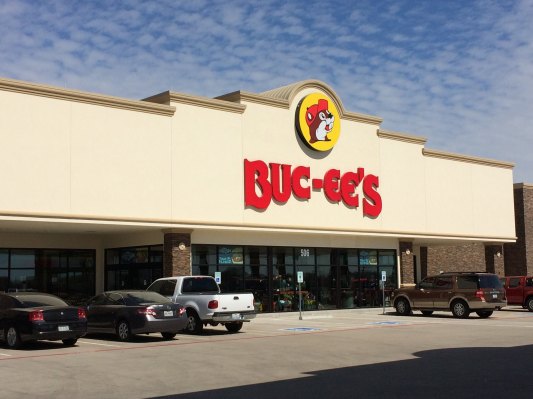If anyone can make EV charging work, it may be Buc-ee’s.
Maybe you’ve heard of the convenience store chain, but if you live outside the Southern U.S., chances are you haven’t experienced one. And they are an experience. Buc-ee’s stores are revered throughout Texas for the cleanliness of their restrooms, the breadth and scale of their food offerings, and the comically large number of pumps at most locations.
With the transition to electric vehicles underway, companies like Buc-ee’s have a lot to lose. While the bulk of the company’s earnings comes from the offerings inside the stores, the real draw is cheap and plentiful gasoline. When demand for that drops, Buc-ee’s and supersize convenience stores will find themselves competing against grocery stores, hypermarkets and stand-alone car washes. Buc-ee’s might be great, but each category already has a wealth of competitors. Part of Buc-ee’s novelty is the fact that you can get all that, at a gas station.
When there’s no gas, what then?
We got a glimpse of Buc-ee’s possible future on Thursday when Mercedes announced that it would build around 30 fast-charging hubs at Buc-ee’s locations throughout the South. Some will open by the end of this year, with the remainder entering operation by the end of next.
Buc-ee’s already hosts Tesla’s Superchargers at a little over half its locations, and one in Alabama has some Electrify America chargers. But the Mercedes deal is bigger, and it suggests that the chain views EV charging as more than just a nice-to-have amenity for passing electric drivers. Indeed, Buc-ee’s website prominently lists EV charging among the fuel types available.
That could be good news for EV drivers. Fast charging is pretty bad if you don’t own a Tesla. The upstart American automaker’s network is the most reliable and has the most locations in the country. As a result, other car companies have been eager to gain access to the Supercharger network, and in the last several months most have negotiated deals that allow their customers to charge at a portion of it.
The opening of Superchargers might help the fast-charging situation in the U.S. And if anyone can turn a profit on fast charging, it’s probably Tesla, which has been building and operating the network for over a decade; it’s worked out the chargers’ kinks — and likely their unit economics, too. It’s been a great way to sell cars, but an open Supercharger network won’t help move Teslas. Instead, it will rely on the same business model that other networks do: charging for electricity. For other EV charging companies, profitability has remained elusive.
Yet allowing other vehicles access also might strain Tesla’s network to the point where its famed availability and reliability suffer. What’s more, the automaker may find that dealing with other companies’ cars (and their software quirks) is not worth the hassle and decide to keep network access constrained.
Convenience stores, though, have long sold low-margin commodities, gasoline and diesel, as a way to entice people to shop inside, where margins are much higher. It’s a model that should transfer nicely to fast charging. However, most existing convenience stores aren’t somewhere drivers want to spend more than a few minutes. They’re cramped and packed with junk food, booze and cigarettes. They’re often dingy, and people use their bathrooms only in their most desperate moments.
Places like Buc-ee’s, though, have taken the convenience store and turned it into something desirable. Buc-ee’s customers spend 45 minutes in the store, according to one report. People wax poetic about the chain’s brisket, jerky and bathrooms. Wait for a pump? Not at Buc-ee’s. Gas stations don’t usually have fan clubs, but Buc-ee’s and other supersize convenience stores in other regions do.
Part of the reason is because Buc-ee’s and its ilk go out of their way to make sure everything is clean and in good working order. The latter is especially appealing to me as an EV driver who has encountered more than a few inoperable DC fast chargers. Plus, the amount of time people spend in the store more than exceeds the typical fast charging time. Perhaps that’s why Mercedes decided to partner with Buc-ee’s.
EV fast charging is a challenging business, but Buc-ee’s approach might succeed. Its vast stores encourage people to linger and spend, not hurry up and leave. That should help offset low margins from fast charging.
Of course, if Buc-ee’s becomes better known for its EV chargers than its gas pumps, then the company will have to ditch one of my favorite billboards: “Eat here, get gas.” A small price to pay for progress.
